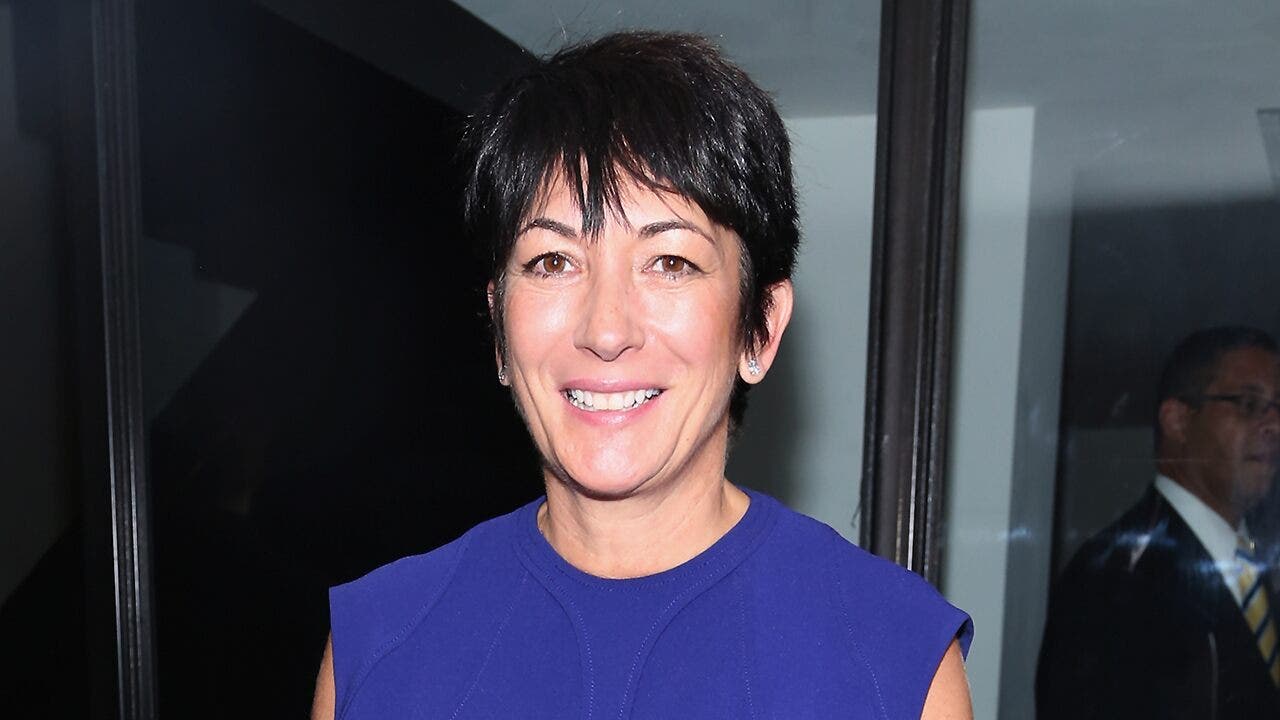Lifestyle
Where does L.A.’s leftover produce go? This group helps get tons to the hungry every day
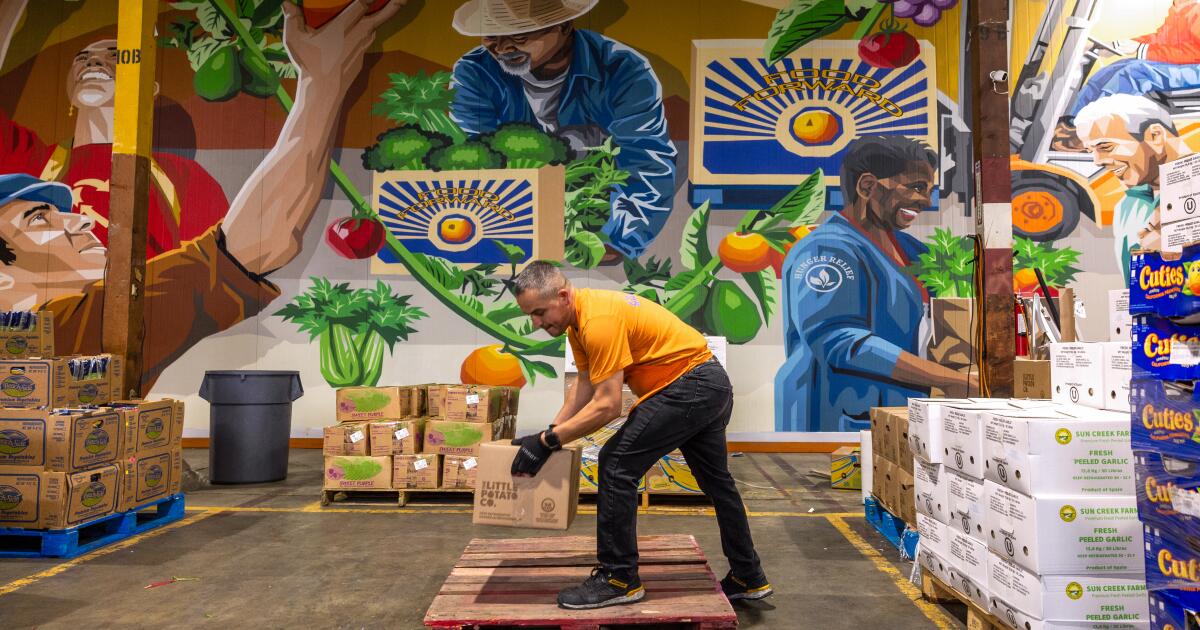
It’s 4:30 a.m. on a Tuesday and the lights are blazing at Food Forward’s Pit Stop warehouse. Big trucks are lining up waiting their turn while forklifts whiz around the loading dock, pulling pallets of donated asparagus, lettuce and strawberries off one truck or pushing boxes of purple potatoes, green beans and heirloom tomatoes onto another headed to needy clients later in the day.
Everything moves fast at Food Forward — a nonprofit devoted to redistributing produce that would otherwise go to waste — because fruits and veggies don’t last. When you’re moving tons of food at the edge of its usefulness — an average of 250,000 pounds or 125 tons every day — no one can afford to dawdle.
Lupe “Papi” Rodriguez uses plastic wrap to stabilize a wobbly pallet of unsold berries, tomatoes and other produce at the Los Angeles Wholesale Produce Market, before loading it into his truck bound for Food Forward’s warehouse.
(Jeanette Marantos / Los Angeles Times)
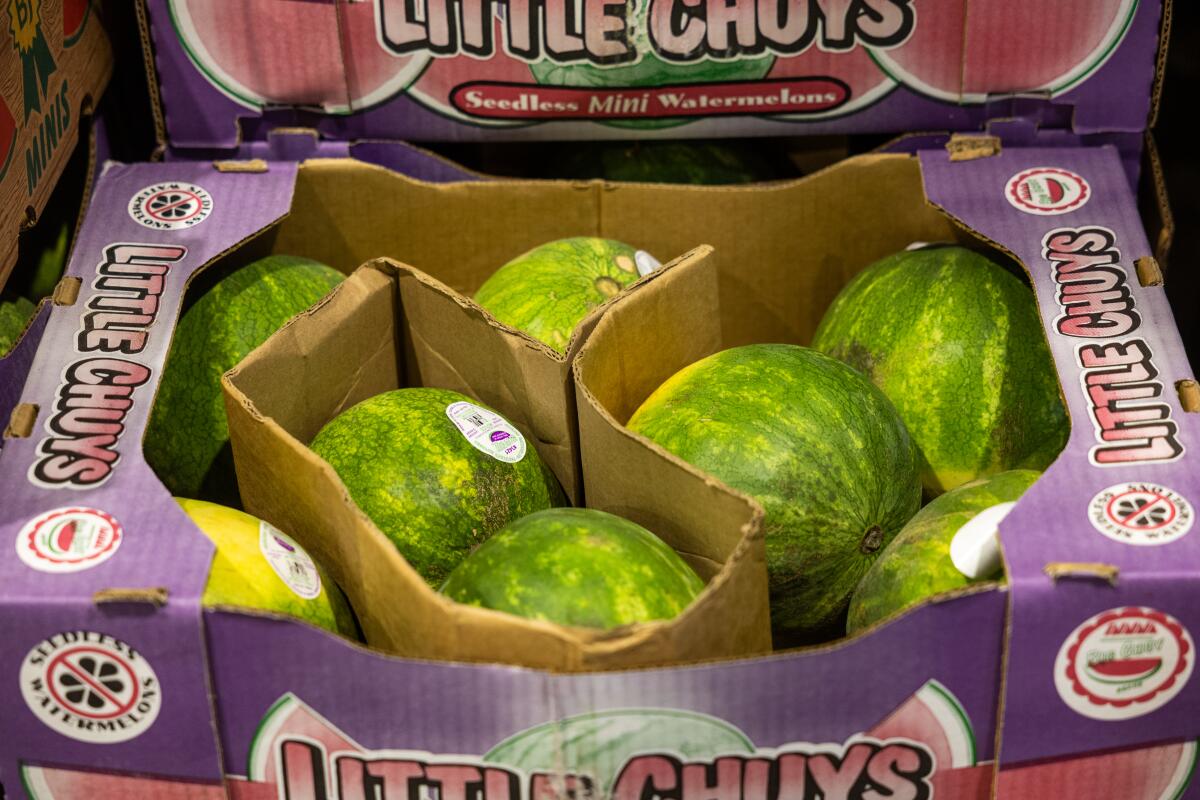
Mini watermelons are among the wide variety of fruit and vegetables brought into Food Forward’s warehouse.
(Myung J. Chun / Los Angeles Times)
The whole point of this hustle is to get food that would otherwise be wasted to hunger relief groups, who get the produce for free and must distribute it for free as well, without imposing any rules like listening to prayers, making donations or joining a club. Food Forward works with some 250 nonprofit groups to get it done, serving 13 counties in Southern and Central California along with seven states and tribal lands when there’s too much surplus for regional groups to handle.
So even though it’s dark and cold, Food Forward driver Lupe “Papi” Rodriguez is smiling as he gets ready to pick up pallets of unwanted fruits and veggies from wholesale produce vendors. “I enjoy my work,” said Rodriguez, who drove a produce truck for 20 years before joining Food Forward in 2021. “It’s a beautiful job, because you get to help people too.”
And it all started 15 years ago, when documentary photographer Rick Nahmias was nursing his ailing, elderly dog and a deep disappointment with politics. During their slow walks through his San Fernando neighborhood, Nahmias had lots of time to notice all the unpicked fruit on people’s trees, and consider how he could best proceed in helping the world.
The year before, Nahmias had worked hard on two political campaigns, to elect Barack Obama as the nation’s first Black president and to defeat Proposition 8, a state ballot initiative to ban gay marriage. Obama won, as did Proposition 8. Although the measure was later overturned, in January 2009 Nahmias was still aching. He and his husband had married just three years earlier, and the vote to ban their marriage “was pretty brutal,” he said.
“It felt like total whiplash, and I was so discouraged, I decided, ‘I can’t deal with politics anymore. I’ve got to go do something positive.’ And Food Forward was my way to turn the other cheek.”
It was also the height of the nation’s economic downturn, he said. “We were seeing long lines at food pantries, who didn’t have the storage to handle fresh fruit. These people were being forced to eat Cup of Noodles when just a mile away there were all these beautiful oranges and grapefruits hanging on trees … and I was thinking, ‘What’s wrong with this picture?’”
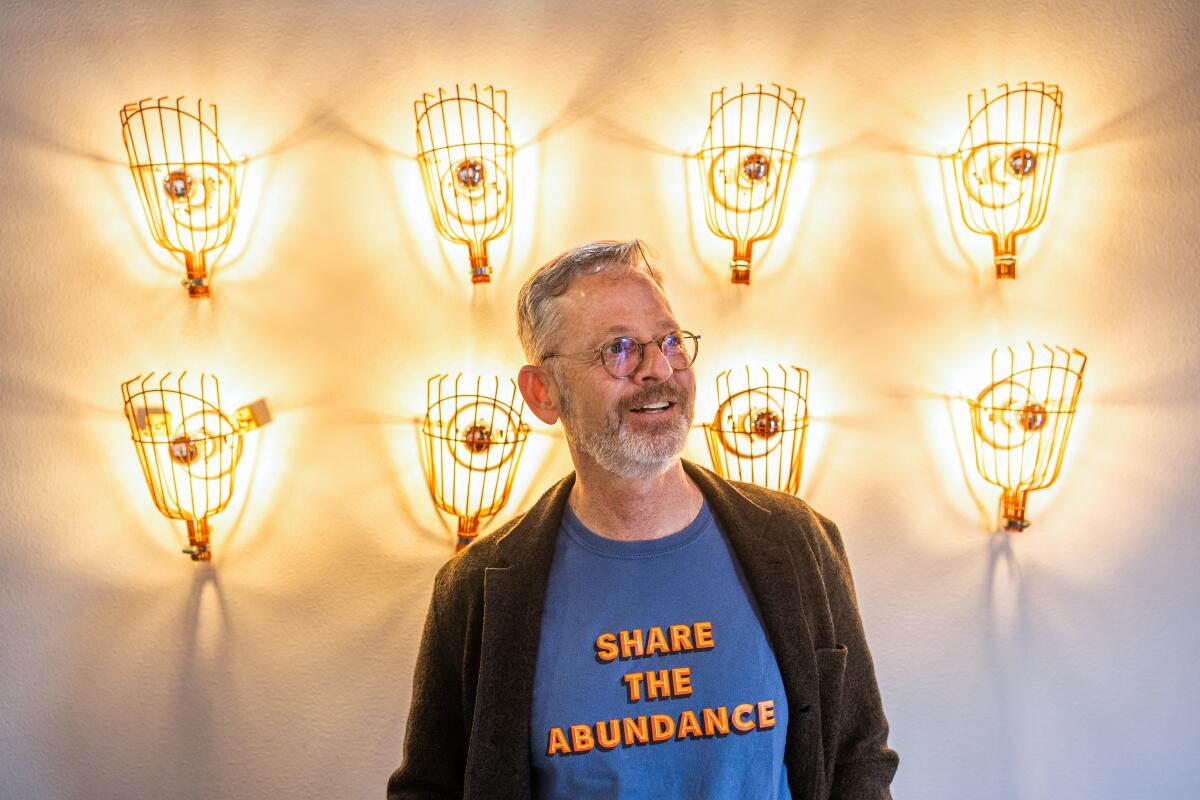
At the Food Forward warehouse, founder and CEO Rick Nahmias poses in front of a sculptural light display created from old fruit harvesting tools, which the organization still uses to glean unwanted fruit from residential trees.
(Myung J. Chun / Los Angeles Times)
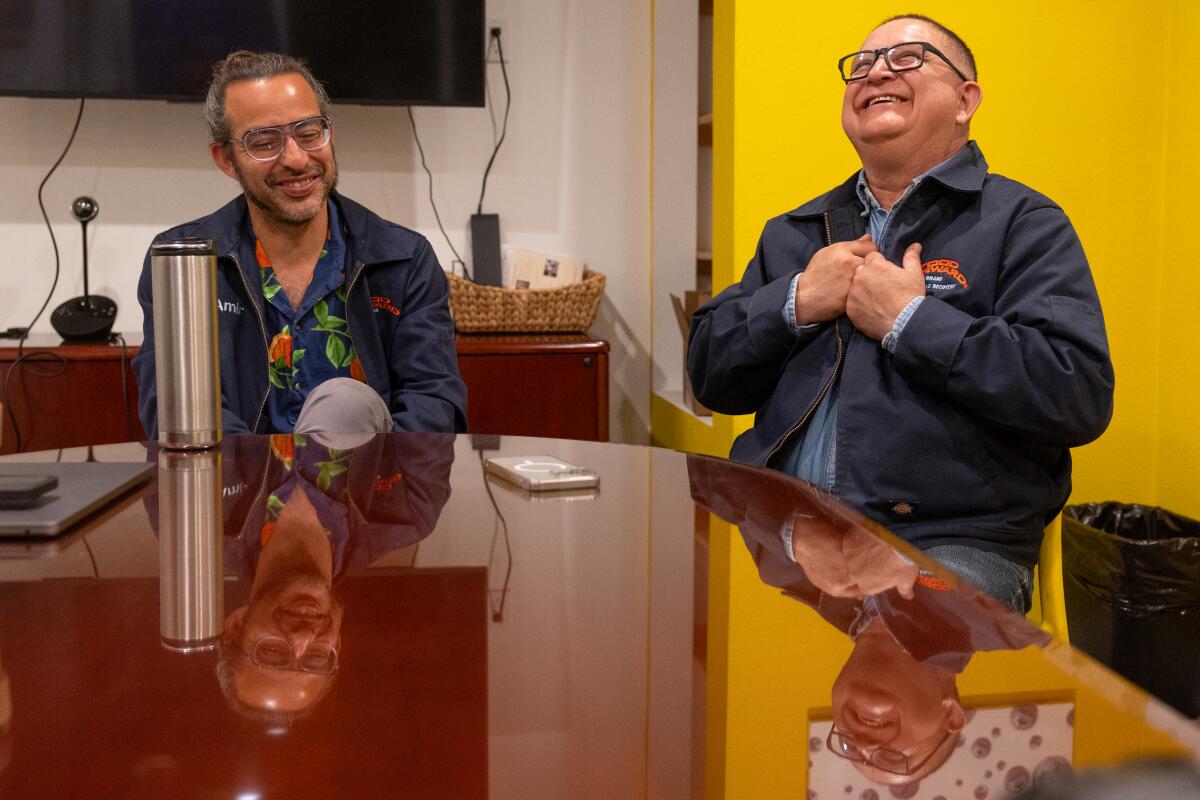
Warehouse manager Leo Paz, right, says it’s rewarding to help the community and to get paid for it as a job. On left is Amir Zambrano, managing director of wholesale recovery.
(Myung J. Chun / Los Angeles Times)
Addressing that imbalance was all Nahmias had in mind when he put an ad on Craigslist that January, asking for volunteers to help him pick unwanted fruit for donation. Six people responded, he said, but only one showed up at the first event. He persisted , and slowly, a group formed that picked 800 pounds of fruit off his neighbor’s tangerine and orange trees, and identified many more that needed picking.
That initial core group — Nahmias, Carl Buratti, Marie Boswell and Erica Kopmar — were all strangers who became close friends, “like a little tribe,” he said. For the next nine months they’d gather on weekends, picking fruit and delivering it to local food pantries. They did it to help people and build community, Nahmias said, but also because it was fun.
A community newspaper wrote a small article about their gleaning events, and in October 2009, while he was shopping for a Halloween costume, Nahmias got a call “out of the blue” from Evan Schlesinger of the Jewish Venture Philanthrophy Fund, offering him a $25,000 grant to see if his weekend “fun” could become a sustainable organization.
Nahmias thought the call was a prank at first, but after confirming it was real, the foursome hired consultants to review its viability. The verdict was yes, if they got nonprofit status and a strong leader, Nahmias said. His “tribe” sat him down and said, “‘This could go somewhere. We should do it,’ but when it came to leadership, they all took a step back.”
Thus Nahmias became the founder and CEO of Food Forward, a gleaning operation that distributed unwanted residential fruit to community organizations feeding needy people. But it didn’t take long for its scope to grow.
By 2012, farmers markets were reaching out to Food Forward, asking if its volunteers could help find a home for the produce left unsold. Farmers didn’t want to take it back, but no one wanted to see it thrown away. What began with the Santa Monica Farmers Market has grown to 16 farmers markets in Los Angeles and Ventura counties.
The biggest jump came in 2014, when Food Forward started working with wholesale produce sellers. “We set 300,000 pounds as our first goal, and ended up collecting 4.1 million pounds,” despite working with borrowed trucks and loading docks, and having to coax vendors to trust the food wouldn’t be resold, Nahmias said.
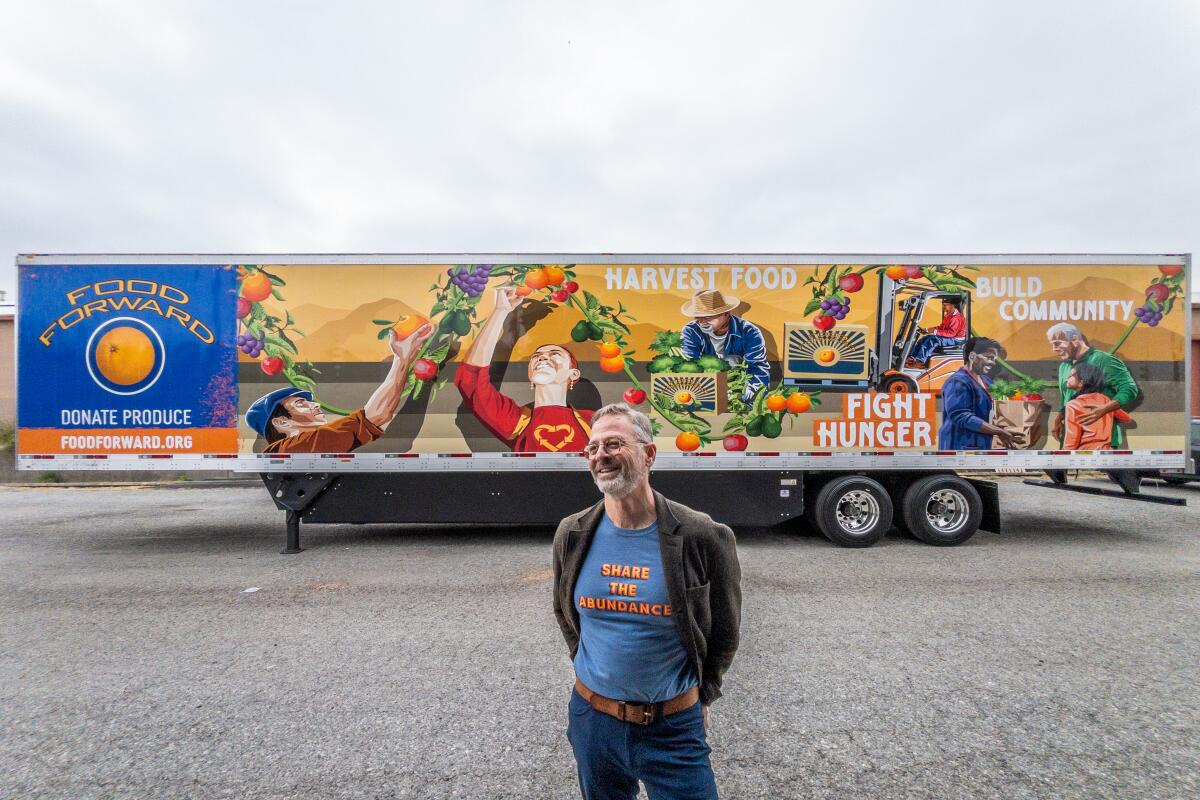
Rick Nahmias stands in front of a new trailer that the organization purchased to help with produce pickups.
(Myung J. Chun / Los Angeles Times)
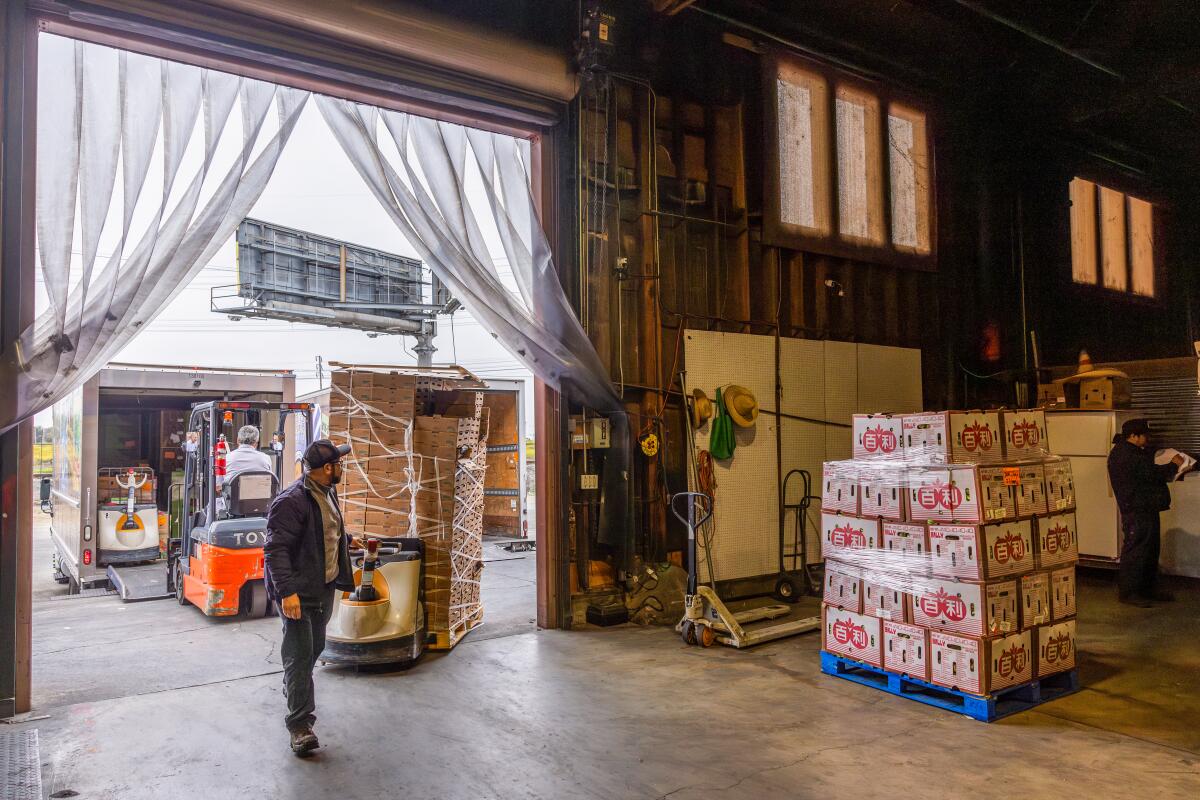
Driver Lupe Rodriguez brings in a pallet of produce he picked up during his early morning route.
(Myung J. Chun / Los Angeles Times)
Now, a decade later, Food Forward’s warehouse and its new giant truck trailer, pulled by an electric Volvo-made cab, features a mural by Brian Peterson depicting its three-pronged attack on hunger: gleaning, farmers markets and its Pit Stop warehouse in Bell, which in 2023 distributed 87 million pounds of free, unwanted produce primarily in Los Angeles County, on a budget of $6.3 million, or at a cost of 7 cents a pound.
The organization has about 50 employees and 2,000 volunteers. Its new goal — recognized by the White House — is to collect and donate 90 million pounds of produce this year, and 100 million pounds by 2025. Funding comes from grants and individual donations, “ranging from $5 to more than $1 million,” Nahmias said.
Back at the warehouse, Rodriguez disappears behind a forklift to unload his truck as warehouse manager Leo Paz congratulates Karlen Nurijanyan, founder and CEO of Student LunchBox, a nonprofit that provides food and other items to college students living in poverty. The group began in 2020, during the pandemic, and initially, Nurijanyan would pick up produce only from the warehouse’s smaller “Sprout” section, which provides boxes of fruits and veggies to groups too small to use big trucks.
This day, however, Nurijanyan has gotten funding to rent a truck big enough to use the Pit Stop loading dock, and he’s thrilled to be getting his first produce on pallets. During college, Nurijanyan was poor, with almost all his money going to rent. After college he got a corporate job but couldn’t shake the memory of his poverty and embarrassment.
When the pandemic forced him to stay at home, Nurijanyan knew it was time to pursue his dream of helping needy college students. Four years later, his group is serving around 4,000 students at 10 universities around L.A. County. The group distributes about 15,000 pounds of food every week, often in open-air “markets” where students can pick the produce they are most likely to eat. Food Forward’s support gave his little organization credibility with other donors, he said, and this year, his program is expanding to include donations of clothing, hygiene kits and other essentials.
This is why people want to work here, said Paz, watching Nurijanyan climb into his rented rig. Paz is all about relationships. He was already working with another hunger relief group when he learned about Food Forward’s growing to work with wholesale vendors. He knew he could have a bigger impact with Food Forward, and his expertise and warmth have helped it grow. Throughout the morning, Paz makes a point of greeting drivers and vendors by name, usually with handshakes that end in hugs.
These kinds of relationships are a large part of why Food Forward has been so successful, Nahmias said, and they must continue for the organization to get the staff and volunteers it needs to grow.
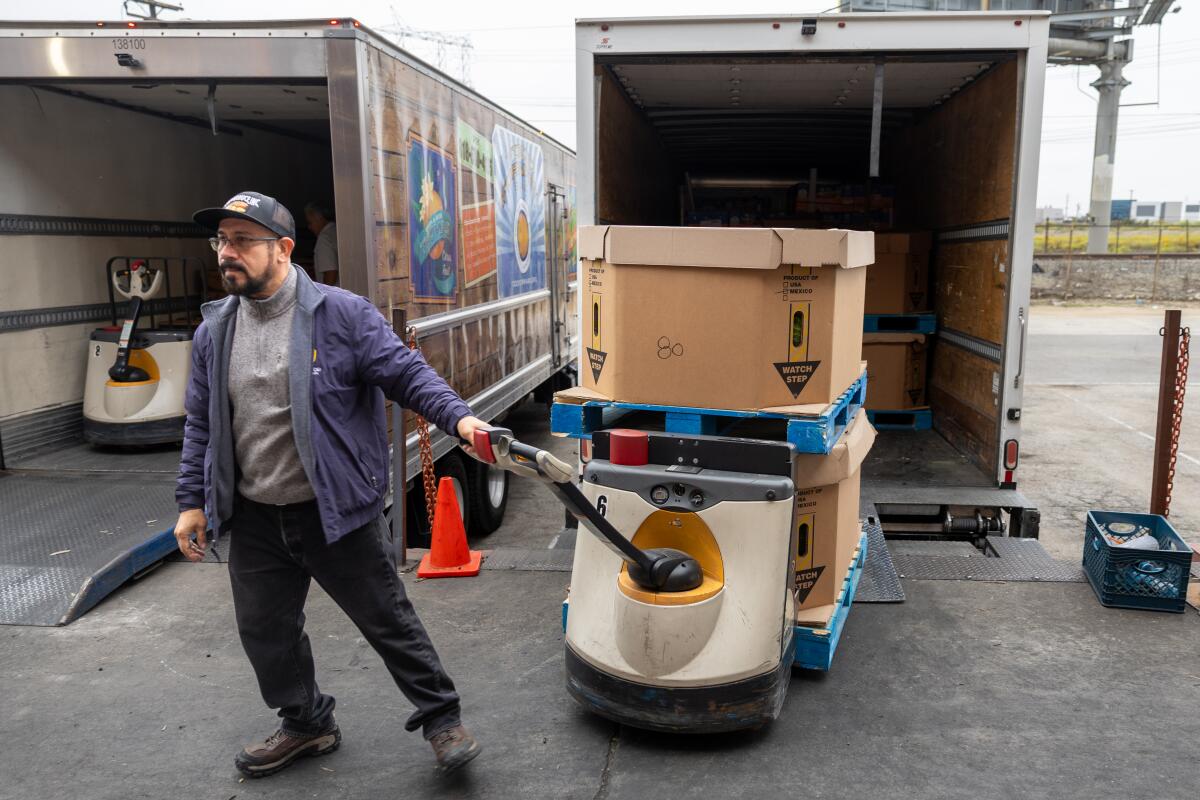
Driver Lupe Rodriguez unloads pallets of produce from his truck at Food Forward Produce Pit Stop.
(Myung J. Chun / Los Angeles Times)
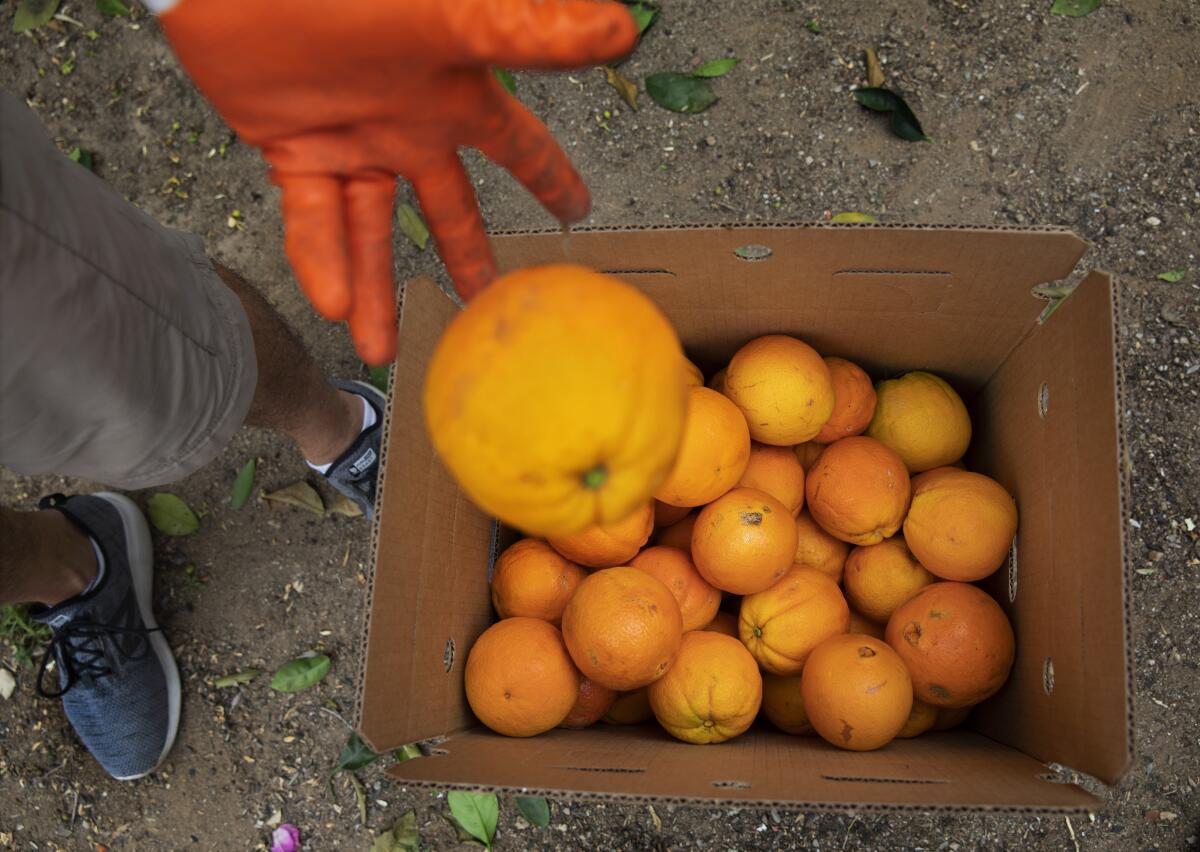
Typically, volunteers from Food Forward harvest thousands of trees, including these navel oranges, picked from a Newbury Park backyard in 2020.
(Mel Melcon / Los Angeles Times)
They’re working hard to bring in more volunteers, said Ally Forest, senior manager of community programs, especially those willing to be trained to lead gleaning and farmers market volunteers. People who are curious can participate in the group’s so-called Zestfest on June 1 at Cal State Northridge’s orange grove, where Food Forward will celebrate 15 years of gleaning fruit by inviting volunteers to harvest hundreds of citrus trees.
And then, after working nonstop since he began, Nahmias is taking a three-month sabbatical to travel, rejuvenate and plan for the future, since visioning is one of his biggest jobs these days.
“‘Share the abundance’ is not just a slogan, it’s a way of life,” he said. “We need to get people out of their own selfish ways and realize how much they have that they can share. It doesn’t have to be fruit; it could be money, time, love. … We all have abundance; we just need to find out what it is, and give it.”

Lifestyle
HBO's new Billy Joel documentary is revelatory — even if it pulls some punches

Billy Joel in 1973.
Don Hunstein/Sony Music Archives/HBO
hide caption
toggle caption
Don Hunstein/Sony Music Archives/HBO
HBO’s two-part documentary Billy Joel: And So It Goes is a revealing look at a complicated music star who has been at the center of pop music for decades.
But it’s also a good example of the challenge filmmakers face in making the modern celebrity biography: a tension between access and objectivity.
To be sure, this project — directed and produced by Susan Lacy and Jessica Levin, veterans of the PBS series American Masters, with superstar executive producers like Tom Hanks and Sean Hayes on board — walks that line very well. The documentary, which debuts Friday with a second part coming July 25, benefits from access to Joel, 76, his family, friends, songs and a tremendous amount of archival material.
When the documentary premiered earlier this year at the Tribeca Film Festival, headlines focused on the admission that Joel had an affair with the wife of a longtime friend and bandmember when he was in his early 20s, attempting suicide twice after the relationship was revealed.
Somehow, the filmmakers got ex-bandmate Jon Small to talk on camera about the moment he learned of the affair — he says “these [were] my two best friends” — alongside extensive interviews with Small’s ex-wife Elizabeth Weber. She eventually married Joel and managed his career through some of his biggest successes in the late 1970s and early 1980s.
There are stars on hand to talk about Joel’s impact, including Paul McCartney (he admits wishing he had written the 1977 ballad hit “Just the Way You Are”), Pink, Nas, Garth Brooks and Bruce Springsteen, who says Joel writes better melodies than he does. But the real revelations come from those who are much closer: his grown children, sister, former bandmates, and his former wives, including supermodel Christie Brinkley.

Billy Joel in 1977.
Art Maillet/Sony Music Archives/HBO
hide caption
toggle caption
Art Maillet/Sony Music Archives/HBO
Weber speaks about how Joel’s increased drinking — and motorcycle-riding — during his major success in the early 1980s led her to leave him after he was in a terrible accident. Both Joel and Weber talk about how spiky lyrics in early songs like “Big Shot” and “Stiletto” were references to their relationship. And other stories about the genesis of his hits sound like stuff scripted for a biopic: He wrote the classic “Piano Man” while working in a piano bar in Los Angeles trying to get out of a terrible recording/publishing contract; “New York State of Mind” came to him quickly on the bus ride to New York City after his time in California.
Still, for me, there is still a slight sense of punches pulled. Joel admits to a lot of terrible behavior during the documentary, from affairs to out-of-control partying, firing longtime bandmembers, writing autobiographical songs with insulting lines about people in his life, burying himself in work and neglecting his loved ones.


But the people on the receiving end of this stuff are mostly shown forgiving Joel for his transgressions and expressing their love and admiration for him — leading this critic to wonder if the picture would have a been a little different if he hadn’t been so intimately involved, to the point where new interviews with him are essentially used as narration for the documentary.
This is a question that surfaces regularly regarding modern documentaries on big stars. When Steve Martin opens up his personal archives for Morgan Neville’s Apple TV+ documentary STEVE! (martin) a documentary in 2 pieces or Michael Jordan’s production company partners with ESPN to create The Last Dance, it’s impossible not to wonder how the story might have been affected by efforts to keep the celebrity excited and involved with the project.
Of course, this can feel like nitpicking. Particularly regarding And So It Goes, which ultimately provides an important reassessment of an artist often given short shrift by music critics during his big pop successes.
The documentary even talks about how Joel would rip up negative reviews from critics onstage back in the day. (Full disclosure: Joel once ripped up a newspaper onstage with a negative review I wrote about his first joint concert with Elton John in the 1990s, though we laughed about it when I interviewed him a few years later, and he didn’t even remember doing it.)


Ultimately, And So It Goes is an expansive, excellent look at Joel’s story – from his early days growing up Jewish in Long Island, right up until the end of his residency last year at Madison Square Garden, which concluded after a decade of performances. (The early screener I saw doesn’t address Joel’s recent announcement that he was diagnosed with a rare brain condition called normal pressure hydrocephalus, leading to cancellation of his concert dates this year.)
And it drops at an important time: A few years past his biggest hits, it’s the perfect moment to look at Joel’s career to see songs with an enduring appeal and impact beyond the trends and concerns of the time when they were first released.
Lifestyle
When a life coach manifests nothing for you but debt and delusion

When Anela Pasalic moved from her rural hometown in Småland, Sweden, to study in the capital of Stockholm, she remembers feeling isolated and severely depressed. It was then that she happened across a glamorous spiritual guru.
Pasalic watched on her phone screen as Kathrin Zenkina shared, from roughly 5,500 miles away in Los Angeles, how she turned her life around through manifestation, which is the philosophy that we can will things into existence by believing they’ll happen. “It just felt like she was an ordinary girl who went for it and had amazing shifts in her life. She also seemed very kind, caring and understanding,” Pasalic says.
For Pasalic, Zenkina felt like an online best friend — one who boasts almost 450,000 followers on Instagram, identifies herself as a “seven-figure entrepreneur” and sells manifestation courses through her business, the Manifestation Babe Academy. Pasalic, who first encountered Zenkina in 2018 when she was 23, took out a payment plan to cover a $1,300 program that Zenkina advertised as the only course one would need to manifest their dreams. Now 30, she estimates she has spent more than $6,000 on Manifestation Babe Academy courses. To pay for them, she borrowed money from family and skipped payments on other bills, like student loans. This was partially due to Zenkina’s suggestion that behaving as though you have money is a technique for attracting it. “I wanted to manifest better circumstances, like me being happy, me having better friendships, me feeling aligned with life,” she explains. Zenkina declined to comment.
Although manifestation has been around since the 1800s, it has moved from the margins to the spotlight amid the recent wellness boom fueled by social media. By summer 2020, Google searches for the term “manifestation” increased, and ample books and podcasts on the practice were released. Since then, the term has been used colloquially (if often semi-ironically) in both pop culture and in everyday life: Sabrina Carpenter employed it in her song “Bed Chem,” and in 2024, “manifest” was Cambridge Dictionary’s word of the year.
“Manifestation” search interest grew in the first half of 2020.
(Google Trends)
At the same time, some life coaches began incorporating manifestation into their services. Their guidance, from relationship to financial to career, can cost $50 per month to thousands of dollars per course. And some followers, like Pasalic, may end up feeling cheated and confused.
The life coaching arena is largely unregulated. Although coaches can receive certifications from various bodies, not all of them do, and these certifications vary in legitimacy as there is no overarching board. “Coaching is not a regulated field, it’s not a regulated practice. … When you see a licensed professional, such as myself or other psychologists, we have accountability to our licensing body,” explains Lynn F. Bufka, head of practice at the American Psychological Association. What’s more, anyone can call themselves a coach.
Zenkina, who doesn’t advertise that she has certifications, teaches manifesting, journaling, tapping specific points on the body while focusing on particular thoughts and taking actions that feel “aligned” with one’s desires. She has clients record themselves vocalizing their wants, turning down the volume on the recording until it’s inaudible, overlaying it with calming music and listening to it on repeat — a technique known as “subliminal hypnosis.” Pasalic attended online programs that involved prerecorded webinars alongside worksheets and live Q&As.
Pasalic followed Zenkina with religious fervor, but her life didn’t change. She began to feel helpless and out of control, especially as most of Zenkina’s teachings focused on inner work over practical change. (As manifestation is intangible, it can be difficult for clients to ascertain whether or not their coaching is “working.”)
“In many ways, manifesting takes the problems with life coaching to a new level, further moving the process away from the concrete, practical advice that coaching should be about and into the abstract, occult, less researched and even riskier realm.”
— Dr. Elias Aboujaoude
“In many ways, manifesting takes the problems with life coaching to a new level, further moving the process away from the concrete, practical advice that coaching should be about and into the abstract, occult, less researched and even riskier realm,” says Dr. Elias Aboujaoude, a psychiatry professor at Stanford University, a research scientist at Cedars-Sinai and the author of “A Leader’s Destiny: Why Psychology, Personality and Character Make All the Difference.”
Zenkina warned her followers that their lives would fall apart before they improved, and that the universe would help them in the “11th hour.” So Pasalic trudged on. Then, in January 2020, her parents convinced her to visit a doctor who prescribed her an antidepressant. The medication helped, but then Zenkina said something that made Pasalic doubt its effectiveness.
On a live Q&A, according to Pasalic, Zenkina said antidepressants can help people get to a higher vibration (spiritual parlance for happiness and positivity), but then, perhaps, they should let them go. “I had been on antidepressants for maybe 10 months. And I was just like, ‘Oh, maybe she’s right. Maybe I should quit antidepressants; maybe I’m better now,” recalls Pasalic.
“If you don’t have any expertise in mental health, you might dangerously cross a line into a territory where you really need to have some expertise in order to be effective,” says Bufka, regarding coaches giving medical advice.
Pasalic says she had a wake-up call when midway through a roughly $2,400 Sovereign Money course — which promised to help disciples “hack the money game using the spiritual laws of money manifestation,” create “generational wealth for lifetimes” and “become recession proof” — didn’t work. She asked for a refund, but was denied.
“I was just so delusional,” Pasalic says. “I was stuck in my life for seven years because I believed what she was teaching.”
To vent, she took to the Life Coach Snark subreddit — one of several forums where people share their experiences with life coaches they suspect are taking advantage of people — and a deluge of similar tales came in. Pasalic says members of the various subreddits fear retribution for speaking out.
Nevertheless, the camaraderie was cathartic. “It felt comforting knowing other people were validating my feelings and what I went through,” she says.
Dane Schwaebe, too, was depressed and unhappy with his life when he stumbled into the coaching universe. A friend had recommended he look into Nick Unsworth, the charismatic founder of Life on Fire, a spiritual life and business coaching program which promises to help people unleash their “god-given potential.” On LinkedIn, he boasts certifications in hypnosis; neuro-linguistic programming, an unproven form of therapy that involves reprogramming how people process information; and time line therapy, which aims to teach people to respond to current circumstances without being informed by the past.
Schwaebe says he was seduced by how Unsworth presents on social media: He lives in a large house in Texas, drives a Dodge Viper sports car and, to Schwaebe, kind of resembles Channing Tatum. He’s also a family man, featuring his wife and three kids heavily in his Instagram content.
In 2018, Schwaebe signed up for a free introductory event in San Diego, about an hour’s drive from his Temecula home. Per Schwaebe’s account, it lasted from early in the morning until late at night, with a 20-minute lunch break, and attendees were asked to turn their phones off and put them away. As well as a group visit to church, Schwaebe says, the event featured new-age spirituality techniques like group meditation, Reiki and manifestation.
Unsworth also allegedly regaled attendees with the story of the time he was deep in debt and turned his life around through coaching (a recurring theme in his content.) “They offer a light, you know? They’re kind of like angler fish … You’re down and you’re in this darkness, and you see a light,” reflects Schwaebe. Unsworth did not respond to multiple requests for comment through his website’s contact form, email and Instagram.
After the free event, Schwaebe says he paid $6,000 for Life on Fire offerings. Per Schwaebe, one course called “Abundance” involved participants shouting a description of the person they wanted to become while a member of Unsworth’s team evaluated how much their eyes widened as they yelled — the wider, the better. Attendees also gathered in a circle to make a confession and confront a group member who resembled someone who had hurt them. Schwaebe chose a woman who reminded him of his birth mom and, per instruction, let it all out, which involved screaming and crying. One of the testimonies on the course’s website reads, “my favorite part of the event was breaking through generational sins, shame and regret.”
“I’m a perfect candidate for this sh—. I had a credit card to cover the coaching balance and was in a depressed, wounded state. I was willing to throw money at whatever would theoretically make me better,” says Schwaebe.
The title of “life coach” could potentially cause confusion, says Aboujaoude. “When life becomes your topic, you are a de facto therapist,” he says. “While any new helping profession is a welcome addition to our well-being landscape, this totally unregulated Wild West risks doing serious harm.”
Another Life on Fire event, Schwaebe says, guided attendees on how to manifest money, freedom and their own business. Schwaebe grew uneasy when Unsworth used it to pitch another course, suggesting those who couldn’t afford it ask someone they know to help pay for it. He also offered a commission for enticing friends and family to join, framing it as a business opportunity, says Schwaebe, who had signed up for the program via his friend’s affiliate link.
Unsworth also offers a course teaching people how to become a life and business coach in 90 days. Indeed, over the past few years, coaches coaching coaches have become a key component of the industry’s business model.
Today, Schwaebe says he is doing better. He’s been diagnosed with depression and ADHD; he takes medication and sees a therapist. He’s also set up an online marketing business, the success of which he attributes to no one but himself.
His advice for anyone considering following a life coach with a manifestation focus? “Don’t drink the Kool-Aid.”
So how can people seeking life and emotional support — whatever the form — navigate that search safely, particularly given the onslaught of coaches with polished social media presences? Bufka recommends asking the practitioner all of the questions you can. “It’s very appropriate to ask questions. How do you know this is effective? When should I expect to see some changes? What will we do to adjust if I’m not seeing the kinds of changes [I need]? You know, asking questions like that can help somebody make a more informed decision,” she says.
She also recommends enlisting the help of a friend, who can weigh in if things start feeling off. And if someone suspects they need mental health support, a qualified professional would best serve their needs, Bufka says. “Seeing the professional with the education and experience in the domain in which you’re struggling is going to be really important,” she says.
Today, Pasalic says she still struggles sometimes because of how much she invested into (and relied on) Zenkina’s teachings, but she feels more independent. “I’m so, so much better and feeling much happier,” she says. “I feel so much more like myself than I did before.”
Lifestyle
Sunday Puzzle: Words ending in “AC”

On-air challenge
Every answer is a word ending in the letters A-C, as in air-conditioning.
Ex. Person who stays awake all night –> INSOMNIAC
1. 12 astrological signs
2. High-quality brandy from France
3. Person with an inflated sense of himself
4. Person who’s lost his memory
5. Substance said to increase sexual desire or pleasure
6. Related to the heart
7. Surface for roads and airport runways
8. Light purple … or a flower with this shade
9. Wood finish
10. Temporary camp, as for soldiers
11. Street with no outlet (hyph.)
12. Miscellaneous ornaments of little value in a display case (hyph.)
13. Shrub or small tree with small reddish fruits used as a spice
14. Reference book filled with miscellaneous facts
15. Emergency removal of patients to or from a hospital
16. Superintelligent person
Last week’s challenge
This is a phonetic challenge in four parts. First, say a letter of the alphabet out loud — like B, C, or L. Then name something you might carry around in your pocket. Say it twice. Finally, name a variety of tree. Say these four things in order, and phonetically they’ll name a nice place in the United States to vacation. What is it?
Challenge answer
Waikiki Beach
Winner
Adam Borden, of Westminster, Colorado.
This week’s challenge
This coming Thursday through Sunday, I’ll be at the 185th convention of the National Puzzlers’ League, which is taking place in Minneapolis. I’ve brought a puzzle by someone else who will also be there — Ben Bass, of Chicago. Take two different articles of clothing and place them one after the other. The result will spell something seen at a baseball game. What is it?
If you know the answer to the challenge, submit it below by Thursday, DATE DATE at 3 p.m. ET. Listeners whose answers are selected win a chance to play the on-air puzzle.
-

 Culture1 week ago
Culture1 week agoTry to Match These Snarky Quotations to Their Novels and Stories
-

 News5 days ago
News5 days agoVideo: Trump Compliments President of Liberia on His ‘Beautiful English’
-
Business1 week ago
Companies keep slashing jobs. How worried should workers be about AI replacing them?
-

 News1 week ago
News1 week agoTexas Flooding Map: See How the Floodwaters Rose Along the Guadalupe River
-
Finance1 week ago
Do you really save money on Prime Day?
-

 News4 days ago
News4 days agoVideo: Clashes After Immigration Raid at California Cannabis Farm
-

 Politics1 week ago
Politics1 week agoJournalist who refused to duck during Trump assassination attempt reflects on Butler rally in new book
-

 Technology1 week ago
Technology1 week agoApple’s latest AirPods are already on sale for $99 before Prime Day













